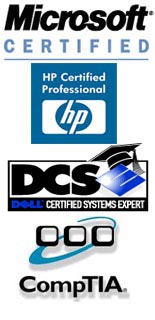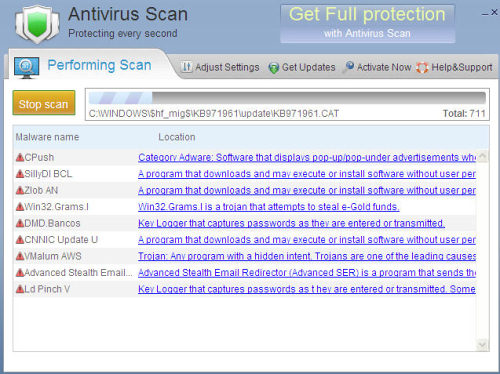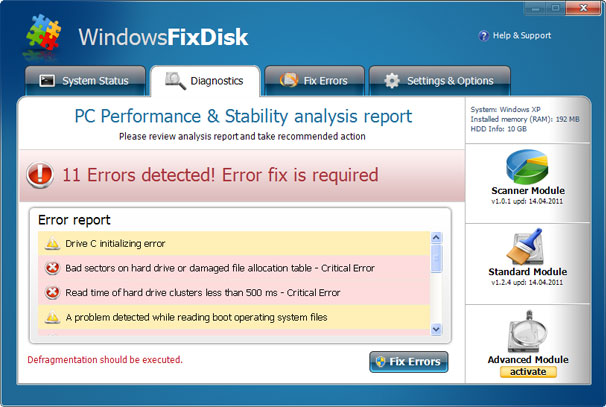|
|
8/24/2011
Antivirus .NET
24/08/11 - Antivirus .NET is the latest of rogue antispyware programs to hit the web. These are
programs that pose as legitimate
utility software, scaring users with fake security scans and
warning messages, however these programs are fraudulent
and are actually spyware
themselves. antiivirus .NET is typically installed via a Trojan, and it usually is found
on
questionable websites (i.e. pornography or gambling), but it has also been found on hijacked
fake news websites
and in torrent downloads. Use one of the automatic removal tools (pcTools
Spyware Doctor) below to remove this rogue
as soon as possible.
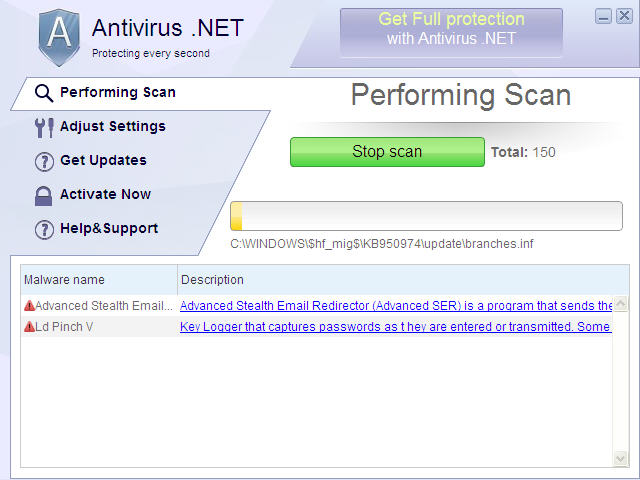 Antivirus
.NET will constantly bombard your computer with phony system alerts and spyware
scans, trying to scare
you into purchasing the full version, which is nothing more than a hoax as
Antivirus .NET is not legitimate software
and is actually a spyware infection. Antivirus .NET can
also hijack your web browser and redirect your search
results to pages of its choosing, where
you will likely encounter more fake alerts and system related warnings.
The larger threat that Antivirus .NET poses however, just as with
any other rogue antispyware
program, is that it can download and install other extremely malicious malware that can log
your
keystrokes, websites visited, browsing habits, etc. and can send that information over the
internet to a remote
server where the hacker that created Antivirus .NET can then use that
information in an attempt to gain access to
your credit cards, bank accounts, and numerous
other sensitive personal information – which can ultimately lead
to identity theft.
     
8:23 pm edt
Milestone Antivirus 24/08/11 - Milestone Antivirus is a rogue anti-spyware program that displays fake security alerts
and reports false infections to scare you into thinking
that your computer is infected with
spyware, adware and other malware. This scareware is promoted mostly through
the use of
Trojans and fake online anti-malware scanners. Once installed, Milestone Antivirus will run a
fake system
scan and display a list of malware infections. Of course, the scan results are totally
false. The rogue program detects
legitimate programs and files as infections, that's why it is best
to use an automatic removal tool (like those
listed below) to remove Milestone Antivirus from
your computer safely.
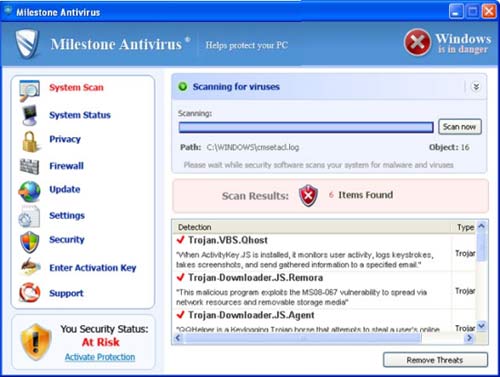 When running, Milestone Antivirus
will flood your computer with fake and very annoying security When running, Milestone Antivirus
will flood your computer with fake and very annoying security
alerts claiming that your computer is seriously compromised
and that you should activate
Milestone Antivirus to ensure full system protection. This fake program will block legit
antivirus
and anti-spyware programs to protect itself from being removed. It will claim that your anti-virus
or any other program actually is infected. The program also has the capability to
impersonate Windows Security
Center and claim that your computer is not protected. Please
ignore it too just like the false scan results and fake
security alerts. If you find that your
computer is infected with Milestone Antivirus, please use one of the automatic removal
tools
below. Please do not purchase it. This is nothing more than a scam. However, if you have
already bought
it then you should contact your credit card company and dispute the charges
as soon as possible.
     
8:12 pm edt
8/23/2011
Security Central 23/08/11 - Security Central is what is known as Rogue Antispyware – meaning that the program
poses as legitimate antispyware software, when
in fact, it is nothing more than spyware itself.
Security Central is installed via a Trojan typically from questionable
websites (i.e. pornography or
gambling), but it has also been found on hijacked fake news websites and in torrent downloads.
Use one of the automatic removal tools below to remove this rogue as soon as possible.
You will see this security
alert msg:
"Security
Central
Threat Found
Alert
Object:
SYSTEMControlSet001ControlSafeBootNetwork
Comment:
Attack
from: 111.90.181.116, port 47333
Attacked port: 10631
Threat: Trojan-DDoS.9"
Security Central will
bombard your computer with numerous fake spyware alerts and scans in an
attempt to lure you into purchasing the full
version, which is nothing more than a hoax because
Security Central is not legitimate software and is actually a malware
infection. Security Central
can also hijack your web browser and redirect your search results to other urls where you
will
encounter additional fake alerts and warnings.
The larger threat that Security Central poses however,
is that it can download and install
keyloggers and other more severe malware that can log your keystrokes, websites visited,
etc.
and can send that information over the internet to a remote server where the hacker that created
Security Central
will then use that information in an attempt to gain access to your credit cards,
bank accounts, and numerous other sensitive
personal information - and may ultimately end up
stealing your identity.
9:57 pm edt
Antivirus Scan
9:32 pm edt
Anti-Malware Lab
23/08/11 - Anti-Malware Lab is dangerous rogue spyware or “scareware”. It is designed to
overwhelm you with simulated scans and fake
warnings that your computer is infected with
various malware. The reason for this is to scare you into buying bogus software
by making you
believe that only the full version of MS Removal Tool can remove these infections, when in fact,
Anti-Malware
Lab IS the infection. Anti-Malware Lab is installed via a Trojan
typically from
questionable websites (i.e. pornography or gambling), but it has also been found on hijacked
fake
news websites and in torrent downloads. You should use one of the automatic removal
tools
listed below to remove this rogue as soon as possible.  Anti-Malware Lab will bombard your
computer with numerous fake spyware alerts and scans in
an attempt to lure you into purchasing the full version, which
is nothing more than a hoax as
Anti-Malware Lab is not legitimate software and is actually a spyware infection. Anti-Malware
Lab can also hijack your web browser and redirect your search results to pages of its choosing,
where you will likely
encounter more fake alerts and spyware related warnings.
The larger threat that Anti-Malware Lab poses however, is that it can download and install key-
loggers and other
more severe malware that can log your keystrokes, websites visited, etc. and
can send that information over the internet
to a remote server where the hacker that created Anti-
Malware Lab will then use that information in an attempt to gain
access to your credit cards,
bank accounts, and numerous other sensitive personal information – and may ultimately
end up
stealing your identity. Contact your banking provider as soon as possible and dispute the
charges.
     
9:26 pm edt
8/21/2011
Windows Care Tool 21/08/11 - Windows Care Tool is a rogue anti-spyware program that displays fake security alerts
and fake threats. This program is installed through the use of Trojans that come from fake online
scanners. Windows Care
Tool will pretend to scan your computer and detect malicious files and
it will not allow them to be removed until
the program is purchased. The rogue program wants to
scare you
into purchasing it. If you find that your computer is infected use one of the removal
programs below to remove Windows
Care Tool and all malware bundled with it.
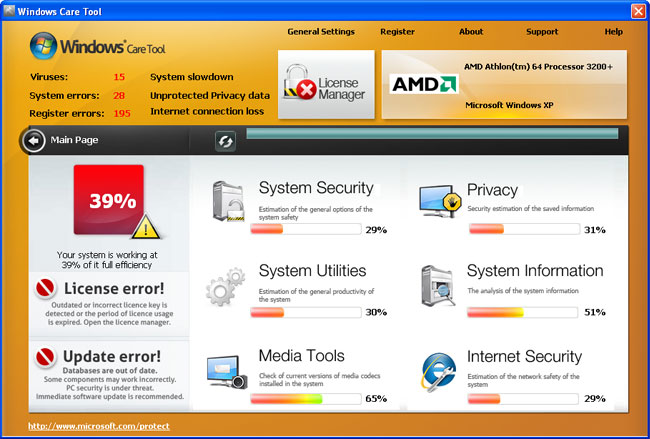 While Windows Care
Tool is running it will also display fake security warnings and alerts on your While Windows Care
Tool is running it will also display fake security warnings and alerts on your
computer. These alerts will state that
an active infection has been found and that you should
purchase Windows Care Tool to remove all malware and viruses to
protect your computer
against other infections. Windows Care Tool will also block certain programs saying that they
are infected. It may hijack your web browser as well.
Windows Care Tool properties:
• Changes browser settings
• Shows commercial
adverts
• Connects itself to the internet
• Stays resident in background
     
1:54 pm edt
8/20/2011
Windows Fix Disk
8:12 pm edt
Check Disk
20/08/11 - Check Disk is a rogue computer defragmenter and analysis program that deliberately
reports fake hard drive, Windows registry and
other system errors. It wants to make you think
that your computer has some serious problems and to scare you into
purchasing the rogue
program. Check Disk pretends to scan your hard drives and system memory for errors. Then it
will state that you need to use the so-called defragment tool to fix the errors. Please
do not fall
victim to this rogue program and remove Check Disk from your computer upon detection. Please
use the
removal instructions below.
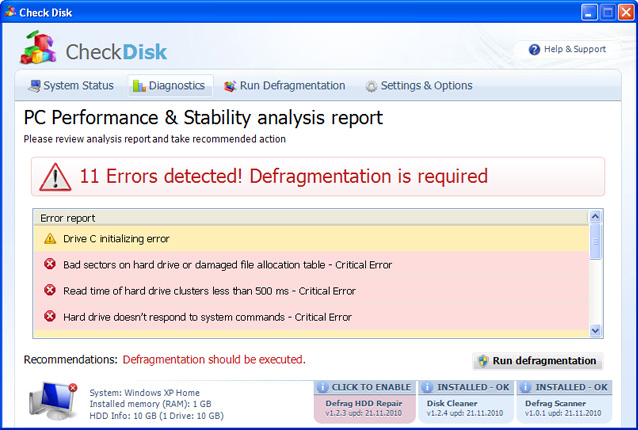 Check Disk is
a clone of Ultra Defragger. Check Disk infiltrates the users
system without Check Disk is
a clone of Ultra Defragger. Check Disk infiltrates the users
system without
permission and (in order to protect itself) attempts to disable legit antimalware software found.
A Compromised computer is completely hijacked by this fake program
allowing Check Disk
to begin the it's malicious campaign. Check Disk is always configured to launch at startup,
so
it will create a large foot print on your system by running fake scanners and pop-up ads and
notifications
that will annoy you. It will also block other programs that are important for a
normal computer operation like notepad,
task manager, registry editor and other system
tools.
Some of the fake alerts read:
Critical
Error!
Damaged hard drive clusters detected. Private data
is at risk.
Critical Error
Hard Drive not found. Missing hard drive.
Critical
Error
RAM memory usage is critically high. RAM memory failure.
The fake system errors it reports:
Requested registry access is not allowed. Registry defragmentation required
Read time of hard drive clusters less than 500 ms
32% of HDD space
is unreadable
Bad sectors on hard drive or damaged file allocation
table
Drive C initializing error
Hard drive doesn't respond to system commands
Data Safety Problem.
System integrity is at risk.
Registry Error - Critical Error
As you can see,
Check Disk is nothing more than a scam. Please do not install it on your
computer. And most importantly, do not purchase
this bogus program. If you have already
purchased it then you should contact your credit card company and dispute the
charges.
Please use one of the automatic removal tools given below.
     
3:22 pm edt
8/18/2011
Malware Doctor
18/08/11 - Malware Doctor also known as Malware Doc is a typical rogue security tool. Malware
Doctor pretends to offer computer security services for a certain fee. However, Malware Doctor is
not a real anti-spyware
application (this rogue only mimics reliable security tools). Malware
Doctor enters the system without a user's permission and knowledge (usually through the use of
trojan Vundo). The main
goal of this parasite is to promote the paid version of Malware Doctor.
Once Malware Doctor is installed and active,
it performs a fake system scan and reports various
bogus results, primarily to inform the user that the computer is seriously infected with malware,
spyware and other parasites. The program then
prompts the user to buy a full version of Malware
Doctor. Malware Doctor won't be able to remove any of the infections
found because it wasn't
designed to do so. Needless to say that Malware Doctor should be removed form the system at
the earliest stage. Use one of the automatic removal tools (like the trustworthy
Spyware Doctor)
to remove this parasite as soon as possible.
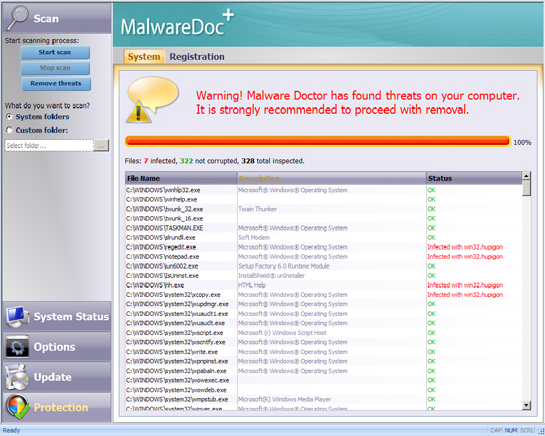 Malware
Doctor properties: Malware
Doctor properties:
• Changes browser settings
• Shows commercial adverts
• Connects
itself to the internet
• Stays resident in background
     
8:16 pm edt
Disk Repair 18/08/11 - Disk Repair is a fake computer
optimization program that displays false errors to scare
you into thinking that there is something wrong with your computer.
Disk Repair is installed with
the help of Trojans that display
fake error messages on the infected computer. These warnings
will state that there is something wrong with your
computer's hard drive and system memory. It
will display
numerous error messages when you attempt to launch programs or delete files too.
Disk Repair is a scam do not be
scared into purchasing the program when you see its alerts and
false scan results. Please use the removal instructions below to remove Disk Repair from your
computer as
soon as possible.
 HDDTools
will terminate some other programs on your computer and state that your hard drive is HDDTools
will terminate some other programs on your computer and state that your hard drive is
corrupted. The warning that you
will see when you attempt run a program is:
Windows detected a hard drive problem.
A hard drive error occurred while starting the application.
While Disk Repair is running
it will also display fake alerts from your Windows taskbar. These
alerts are designed to further scare you into
thinking that your computer has problrms. The text
of some of
the alerts you may see include:
Critical Error!
Damaged hard drive clusters detected. Private data is at risk.
Critical Error
Hard Drive not found. Missing hard drive.
Critical Error
RAM memory usage is critically high. RAM memory failure.
Without a doubt, Disk Repair is a scam. Do not purchase
it for any reason, and if you already
have, please contact your credit card company and dispute the charge. The
please use the
removal guide below. We strongly recommend you to scan your computer with Spyware Doctoror any other legitimate anti-spyware programs to make sure that there
are not other malware
installed on your computer.
Disk Repair
properties:
• Changes browser settings
• Shows commercial adverts
• Connects itself
to the internet• Stays resident in background
     
5:48 pm edt
Windows Optimization & Security 18/08/11 - Windows Optimization & Security is a rogue computer optimization application that
displays fake security
threats and privacy issues to make you think that your computer is
infected and has some other serious problems. It's
promoted through the use of a Trojan that
impersonates the fake Microsoft Security Essentials Alert. The rogue program
is distribute via
fake online scanners, infected websites and other malware. It may be also distributed on social
networks. Once installed,Windows Optimization & Security will pretend to scan the computer for
various problems
and errors and after the fake scan it will report numerous critical errors and
system problems to scare you into thinking
that your computer is infected. The user is then
prompted to install additional modules to remove the threats which is
obviously not free. Do not
buy it. Instead, please remove Windows Optimization & Security from your computer with
an
automatic removal tool.
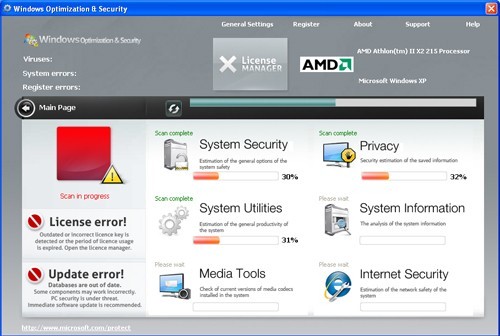 Windows Optimization & Security
blocks other programs on the compromised computer. It Windows Optimization & Security
blocks other programs on the compromised computer. It
blocks web browsers and Windows utilities stating that they are
infected and may cause serious
damage to the system. It displays fake security alerts and notifications too. Windows
Optimization & Security states that your sensitive data is at risk, your privacy is compromised
and your Internet
security is disabled. Some of the messages you will see are:
"Threat
prevention solution found"
Security system analysis has revealed critical file
system vulnerability caused by severe
malware attacks.
Risk of system files infection:
The detected
vulnerability may result in unauthorized access to private information and hard
drive data with a seriuos possibility of irreversible data loss and unstable PC performance. To
remove the malware please run a full system scan. Press ‘OK’ to install the software
necessary to initiate system files check. To complete the installation process please reboot
your computer.
"Attention"
Software without a digital certificate is detected. System files security is at risk.
It is strongly recommended to enable the security mode.
"Microsoft Security
Essentials Alert"
Potential Threat Details
Microsoft Security Essentials detected potential threats that might compromise your private
or damage your computer. Your access to these items may be suspended until you take an
action. Click 'show details' to learn more.
As you can see, Windows Optimization
& Security is a scam. It displays fake error messages
and security alerts to make you think that your computer is
infected. Then it prompts the user to
pay for a full version of the program to clean up the computer. Please use anti-spyware
software
to remove Windows Optimization & Security from the system as soon as possible.
     
5:18 pm edt
8/17/2011
Trojan-BNK.Win32.Keylogger.gen 17/08/11 - Trojan-BNK.Win32.Keylogger.gen is a dangerous infection that spreads through XP
Internet Security 2010 rogue anti-spyware program. It is not a real virus and it appears only if the
system is infected with XP Internet Security 2010. 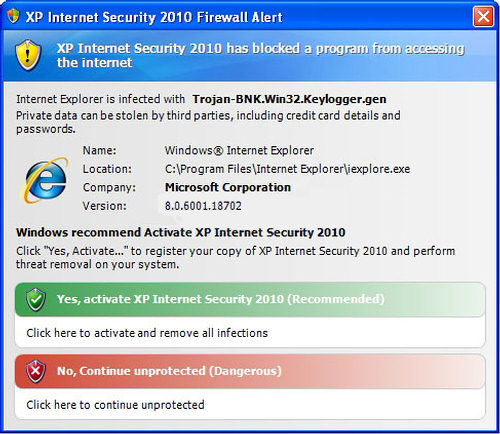 Once a computer is infected with
this fake application and you try to browse some Internet Once a computer is infected with
this fake application and you try to browse some Internet
websites, XP Internet Security 2010 keeps displaying fake
notifications claiming that your
system is infected with Trojan-BNK.Win32.Keylogger.gen. The warning states that
your private
data (passwords, credit card details, etc.) might be stolen. However, this warning is a total lie.
Trojan-BNK.Win32.Keylogger.gen was only designed to scare people into thinking it’s a
dangerous infection.
No such parasite exists on your computer and it is displayed just
because you are infected with XP Internet Security
2010. This is the only application that must
be removed.
Once you get notifications that you are infected
with Trojan-BNK.Win32.Keylogger.gen,
concentrate on removing XP Internet Security 2010 application. Use pcTools
Spyware Doctor
or one of the automatic removal tools below to eliminate this program.
     
7:45 am edt
8/16/2011
Win 7 Home Security 2012
9:35 pm edt
8/15/2011
W32.HLLW.Gaobot.AA 15/08/11 - W32.HLLW.Gaobot.AA is a worm that attempts to spread to the network shares with
weak passwords. The worm
also allows a hacker access to an infected computer through the
IRC.
It infects a computer
in a variety of ways; unknown email-attachments, unsafe file sharing or free
software downloading can be a gateway to
a W32.HLLW.Gaobot.AA infection. It also encrypts
files before forcing unwary users to pay for a password to decrypt the
files.
W32.HLLW.Gaobot.AA is made by the attacker to get unauthorized access to your computer
and controlling
the PC without the user”s knowledge. This attack could pose a serious security
threat... It is recommended you
use pcTools Registry Mechanic to repair the registry and then
download pcTools Spyware Doctor to remove this low level
worm from your systems. If you have
valid antivirus software installed, you will still need to remove it, repair the
registry and reinstall,
before you can eradicate the worm. You can also use one of the automatic removal tools below
to repair your system.
W32.HLLW.Gaobot.AA properties:
• Allows remote user connection
• Hides from the user
• Stays resident in background
     
2:43 pm edt
8/14/2011
Wolfram Antivirus 14/08/11 - Wolfram Antivirus is a rogue
anti-spyware program that displays fake security alerts
and reports
false infections to scare you into thinking that your computer is infected with
spyware, adware and other malware.
This scareware is promoted mostly through the use
of Trojans and fake online anti-malware scanners. Once installed,
Wolfram Antivirus will run a
fake system scan and display a list of malware infections. Of course, the scan results are totally
false. The rogue program detects legitimate programs and files
as infections. Use one of the
automatic removal programs below
(pcTools 'Spyware Doctor') to remove Wolfram Antivirus from
your computer safely. 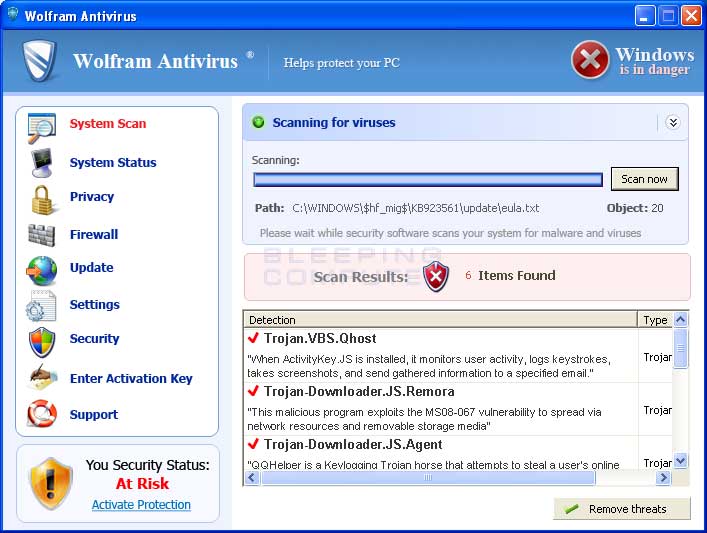 When running, Wolfram Antivirus will flood your computer with fake and very annoying security When running, Wolfram Antivirus will flood your computer with fake and very annoying security
alerts claiming that your computer
is seriously compromised and that you should activate
Wolfram Antivirus to ensure full system protection. This
fake program will blocks legitimate
antivirus and anti-spyware programs to protect itself from being removed. It will claim that
your anti-virus or any other program actually
is infected. This rogue program will also
impersonate Windows Security Center and claim that your computer is not protected. Please
ignore the false scan results and fake security
alerts. If you find that your computer is infected
with Wolfram Antivirus, please remove it as soon as possible. This
is a scam with the intent of
tricking users into purchasing Wolfram AV. However, if you have already bought it then
you
should contact your credit card company and dispute
the charges as soon as possible.
Once again, use one of the automatic removal tools below.
     
5:22 pm edt
ErrorSafe 14/08/11 - ErrorSafe is
a rogue anti-spyware program (a clone of WinFixer). This program gets
installed insidiously via Trojans and browser security holes. When active, ErrorSafe proceeds to
bombard the user with popups and
fake system notifications warning him that he is infected. The
trial version of the program generates a falsified system scan report to confirm these worries. The
user is then asked to pay for the "full
version" (which is a fake) to remove these threats.
 ErrorSafe is a scam
and should not be trusted: do NOT download or buy it and block ErrorSafe is a scam
and should not be trusted: do NOT download or buy it and block
errorsafe.com using your HOSTS file. Use an automatic removal tool to get this off your
system.
     
8:10 am edt
Personal Shield Pro
14/08/11
- Personal Shield Pro is a fake anti-spyware application that enters a computer with the
help of Trojans, malicious
software and infected wbsites. It is from the same family as Antivirus
Scan and Antivirus Action. Once installed, Personal
Shield Pro will display fake security alerts
and warnings about computer infections and attacks from the internet. The
rogue application will
block almost all programs to protect itself from being deleted or disabled. To make things even
more complicated, it will hijack Internet Explorer and change LAN Settings. Personal Shield Pro
v1.0 enables a proxy
server for LANs and blocks security related programs and antivirus software
websites.
Personal Shield Pro is also distributed
using social engineering. The main goal of Personal Shield
Pro is to trick you into purchasing the program. In order
to achieve its goals, the misleading
application will simulate a system scan and report false scan results. The rogue
program will
state that your computer is infected with Trojans, worms and spyware, then it will ask you to pay
for
a full version of the program to remove the infections which do not exist. Do not purchase it!
What is more, Personal Shield Pro will display a legitimate looking Windows Security Center and
state that Windows
did not find any anti-virus software on your computer and that Windows
software is not updated. The rogue program
will suggest you to activate Personal Shield Pro in
order to protect your computer. When this fake anti-spyware application
is running, you will also
see many fake security alerts. Some of them will state:
"Your computer is being attacked by an Internet Virus. It could be a password-stealing
attack, a trojan-dropper
or similar. Threat: Wind32/Nuqel.E"
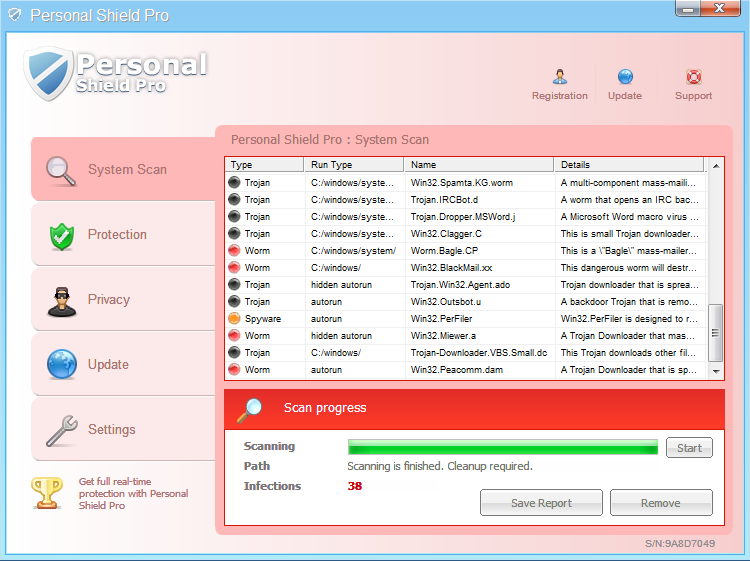 As you can see, Personal Shield Pro is a scam... a useless application. Before you can remove this infection you have
to end all processes associated with Personal Shield Pro malware or reboot your computer in safe mode with networking.
Otherwise you won't be able to run any anti- spyware/virus software. You can remove it manually but we strongly recommend
you to use an automatic removal tool (listed below) because the rogue application may come bundled with other malware.      
7:04 am edt
8/13/2011
RegistryPowerCleaner
13/08/11 - RegistryPowerCleaner is a rogue registry cleaner. This program pretends to be a
highly effective tool, but it is really a scam just like any other scam roaming the internet.
RegistryPowerCleaner uses scare
tactics (popups, fake system notifications) to convince users
to buy the fake full version.
RegistryPowerCleaner
is a clone of AVSystemCare and many others - a fact made clear upon
visiting registrypowercleaner.com. Do NOT trust RegistryPowerCleaner
- it does not work. If you
have it - remove it and block registrypowercleaner.com from using your HOSTS file.
     
5:27 pm edt
Vista Internet Security 2012 13/08/11 - Vista Internet Security 2012 is not what you may think – after checking it with a
reputable
updated anti-spyware you will clearly see that it is a malware. It’s definitely not a
legitimate anti-spyware dedicated
for computers running Windows Vista, but a rogueware which
will try to steal your money. This program was designed quite
differently from other “popular” and
“famous” roguewares because just after intrusion it sets
its name according to the OS it finds.
More than 15 rogue anti-spywares all look and act identically and begin everything
with a secret
intrusion. Vista Internet Security 2012 also relies on trojans that use security vulnerabilities to
get inside undetected. Then, the viruses also modify some system parameters to make sure
Vista Internet Security
2012 is launched after every reboot of computer.
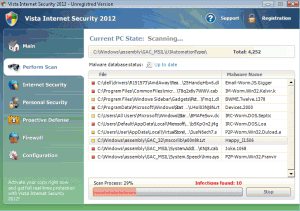
This becomes clear when the malware starts showing fake system scanners, alerts and
notifications. These
scanners will definitely claim that there are numerous viruses on your PC
and that your system security is in danger.
However, in reality cyber criminals are trying to make
you believe that Vista Internet Security 2012 is actually scanning
your computer for infections
and detecting malicious activity. Please, do not fall for Vista Internet Security 2012 deceptive
notifications and alerts (that only seek to create a need of anti-spyware program). Additionally,
Vista Internet Security
2012 will prompt you to purchase its so called “full” version for removal
while it is not capable of doing
anything but infecting your computer system. These classic
tactics should be ignored, but keep in mind that you must
remove Vista Internet Security
immediately. Use one of the automatic removal tools below.
     
5:20 pm edt
Aid Trojan 12/08/11 - Aid Trojan, like other trojans,
is a sneaky parasite that infects a system and starts
working silently. It starts its attack by: gathering system information
and sending it to a defined
address, performing a set of actions (most of which can be really destructive) on the infected
computer. A user can infect his or her system with this trojan by running suspicious files from
various sources (such
as e-mails from unknown addresses, ICQ or some other internet pages).
Aid
Trojan properties:
• Hides from the user
• Stays resident in background
     
5:07 pm edt
Chota
12/08/11 - Chota is a malicious keylogger designed
to record all user keystrokes. It saves
gathered data to a file. The threat doesn't have any additional functionality.
Chota is one of the
tiniest keyloggers, and it consists of a single executable, with a size that is smaller than 750
bytes.
Chota properties:
• Logs keystrokes
• Hides
from the user
• Stays resident in background
     
5:00 pm edt
8/11/2011
Adware Away 11/08/11 - Adware Away is a rogue anti-spyware application and also a fake diagnostic tool
for
the Windows operating system. It is advertised as a reliable tool with abilities to remove various
infections
(including adware, spyware, browser hijackers, Trojans, and worms). However, the truth
is that Adware Away is secretly
installed through the use of trojan viruses when browsing
malicious websites and has nothing to do with computer protection. The main aim of this rogue
is to trick users into spending money on a bogus
product.
Once installed and active, Adware Away runs counterfeit PC scans and floods the system with
pop-up windows stating that user's computer is seriously infected. Of course, those
infections
were made up in order to scare the user. Normally, the user has to ignore such disinformation
and remove
Adware Away from the system completely. Otherwise, this parasite may
cause even more damage to the system. The best option is to remove Adware Away as soon as
possible. 'Spyware Doctor'
is the automatic tool of choice to remove this parasite immediately.
 Adware Away properties: Adware Away properties:
• Changes browser settings
• Shows commercial adverts
• Connects itself to the internet
•
Stays resident in background
     
5:38 am edt
8/10/2011
"Warning! Fatal error:" 10/08/11- "Warning! Fatal error:" wallpaper, is a fake alert notice produced by WinCoDecPRO,
which is
another rogue application, pretending to be the Windows multimedia coder/decoder.
After infection, WinCoDecPRO modifies
Windows wallpaper without the user's permission. It
displays disinformation that all your media systems and their components
are corrupt and have
crashed due to a fatal error. "Warning! Fatal error:" wallpaper reads:
"Warning! Fatal error:
All media systems on your computer have been crashed!
Attention! Media components
on your computer have been corrupted due to fatal error! Your
system can't play audio video files and use media applications!
To resolve this issue and restore your system, update your media codec immediately!"
 It is very important to ignore
this fake information and remove WinCoDecPRO from the system as It is very important to ignore
this fake information and remove WinCoDecPRO from the system as
soon as possible (after detection). Any delay in removal can
result in severe damage. Use one of
the automatic removal tools below to resolve this problem.
"Warning!
Fatal error:" wallpaper properties:
• Changes browser settings
• Shows commercial adverts
• Hides from the user
• Stays resident in background
     
11:41 pm edt
Edepol 10/08/11 - Edepol is a parasitic keylogger that records all user keystrokes and transfers gathered
data to a predefined remote host. The
threat injects malicious code into running legitimate
processes in order to hide its activity and presence in the system.
Edepol automatically runs on
every Windows startup. Use one of the automatic removal tools below to remove this parasite
from your system.
Edepol properties:
• Logs keystrokes
• Connects itself to the internet
• Hides from the user
• Stays resident in background
     
11:28 pm edt
8/9/2011
System Smart Security 09/08/11 - System Smart Security is a rogue anti-spyware program from the same family as
Internet Security
Essentials. Once installed, this fake program will create harmless files on your
computer and later will flag those files
as system security threats. It will also display numerous
security warnings to make you think that your computer is infected
with malware. And finally, it
will prompt you to pay for a full version of the program to remove the infections which
don't exist.
It goes without saying that System Smart Security is a scam. Don't buy it! Instead, please use
the
removal instructions below to remove System Smart Security from your computer as soon as
possible.
Most of
the time, System Smart Security must be manually installed, but it may come bundled
with other malware too. Sometimes,
people say that such fake programs pops up from
nowhere and usually that's true. Trojan horses enter computers through
software vulnerabilities
and then download rogue programs on the compromised computers. When running, System
Smart
Security will simulate system scans and display fake security warnings. Of course, you
will see more such fake warnings,
but just like the false scan results they can be safely ignored.
Please also note that System Smart Security may block
legitimate security programs to protect
itself from being removed. It will hijack Internet Explorer and modify Windows
hosts file too. As
you can see, this fake program is absolutely needless and dangerous. It may cause many
problems
to your computer. If you find that your PC is infected with this rogue program then
please use automatic removal
tools listed below.
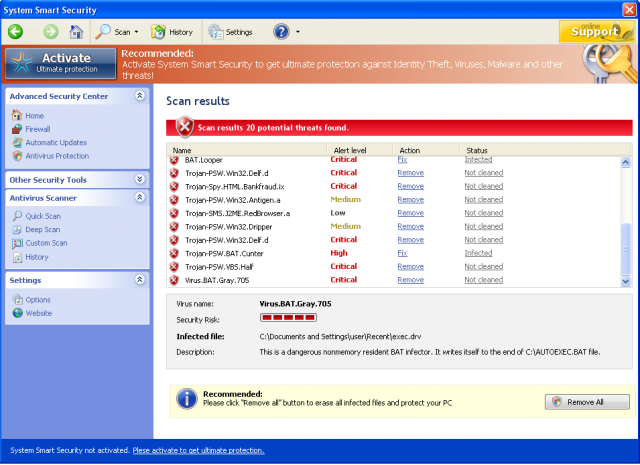      
11:55 pm edt
XP Anti-Virus 2011 09/08/2011 - XP Anti-Virus 2011 is a rogue anti-spyware program which applies the basic tricks
of scams
from this category. Though it claims to be a powerful virus remover, it must be
eliminated because it manufactures
counterfit viruses. The rogue program will pretend to scan
your computer and immediately will report numerous viruses.
Some of its alerts may identify
Trojan-BNK.Win32.Keylogger.gen threats to scare and push users into purchasing its
license
which will be offered additionally. Pay attention to the fact, that XP Anti-Virus is dangerous and
has nothing
to do with system security!
XP Anti-Virus 2011 program has been manipulating people into believing it is useful
software.
However, this rogue anti-spyware mostly penetrates a random computer system without the
user’s
knowledge or approval and, opens the backdoor of the system to let more threats in while
allowing the scammers to reach
your personal information. All this is done with a help of Trojans
that infect vulnerable systems through fake online
scanners. As you can see, you should not
believe XP Anti-Virus 2011 and its spyware detection reports as they are fabricated
and
have nothing to do with the true condition of the users machine. Don’t buy this software (it will
definitely
promise to fix your computer) Remove XP Anti-Virus 2011 as soon as possible.
 SPECIAL
NOTES FOR XP ANTI-VIRUS (2011) REMOVAL: SPECIAL
NOTES FOR XP ANTI-VIRUS (2011) REMOVAL:
1. Firstly, type this registry code into its manual registration section
to disable alerts interrupting
when trying to remove malware: 1147-175591-6550 .
2. If this
fails, reboot machine into Safe Mode with networking with a help of F8, launch task
manager and stop all 3-letter named
processes, also processes named like garbage.
3. Search for malware files on hard disk and delete them, edit registry.
You can also use
automatic removal program or Spyware Doctor for the last action.
4. Reboot, update your
antivirus programs (preferably to internet security versions) and scan
again. Make sure you got all the trojans out.
XP Anti-Virus 2011 properties:
• Changes browser settings
• Shows commercial
adverts
• Connects itself to the internet
• Stays resident in background
     
8:38 pm edt
1840 trojan 09/08/2011 - This trojan, originated in 2003, has
nothing different from parasites of its kind. It can
be a useful tool
in hands of the hacker by silently monitoring an infected computer. While there
is almost nothing that could distinguish
'1840' from other trojans, it still remains quite a
dangerous threat to all users who haven't got security systems that are strong enough to catch
this parasite.
1840 trojan properties:
• Connects itself to the internet
• Hides from the user
• Stays resident
in background
     
1:41 am edt
Windows Problems Solution 08/08/2011 - Windows Problems Solution is a rogue anti-spyware program that displays fake
security warnings and prompts the user to register the program
to remove the infections. It
pretends to scan the computer for viruses and system errors and states that your computer
is
infected with malware.
If you want to remove the infections you have to pay for a full version of
Windows Problems
Solution. Of course, you shouldn't do that because this program is a scam. It want to fix any
errors (simply because they are all fake) remember, fake scan results are a method to scare
you into purchasing the
program. You should remove Windows Problems Solution from your
computer as soon as possible. Windows Problems Solution
will constantly display fake error
messages stating that your computer is infected with keyloggers and/or other
viruses. Once
installed, Windows Problems Solution will prompt you to start your computer in protected mode
to
ensure that your computer is properly protected against possible attacks and malware.
However, in reality it blocks programs
on your computer randomly and states that they are
infected or potentially harmful.
Microsoft Security
Essentials Alert
Privacy violation threat detected.
Your personal data may be disclosed to a third party.
Microsoft
Security Essentials detected potential threats that might compromise your
privacy or damage your computer. Your access
to these items may be suspended until
you take an action. Click 'Show Details' to learn more.
Unknown Win32/Trojan
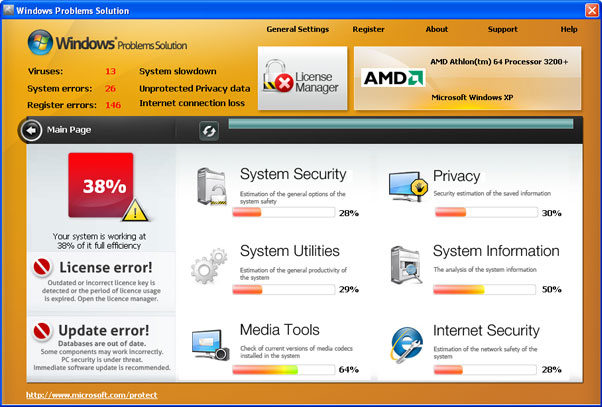 Windows Problems Solution is nothing
more than a fraud. It displays fake error messages and Windows Problems Solution is nothing
more than a fraud. It displays fake error messages and
security alerts to make you think that your computer is infected,
then it prompts you to pay for
a full version of the program to clean up the computer. Do not buy. Use our
automatic removal
tools below to remove Windows Problems Solution from your system upon detection.      
12:32 am edt
ExeBug Trojan
08/08/2011 - This dangerous trojan usually
deals with EXE-files by changing their headers and
contents. These actions may lead to improper working of many applications
and the system
instability in whole. ExeBug Trojan usually sneaks into the system from various Internet
resources (such as suspicious web pages or peer-to-peer networks), that's why it's strongly
recommended to keep your antiviral databases updated. Delete files:
08867e.vom, 0886bb.vom
ExeBug Trojan properties:
• Hides from the user
     
12:08 am edt
Advanced Spyware Detector 08/08/11 - Advanced Spyware Detector is another rogue anti-spyware application, fake spyware
remover.
Like many similar rogue programs, AdvancedSpyware Detector was designed to steal
money from simple-hearted people. To
achieve it's goal Advanced Spyware Detector uses
horrendous methods and continuously displays irritating pop-up windows
or other similar fake
messages hopping that user will buy full version of this worthless product.
Advanced
Spyware Detector is quite dangerous infection. Though it was developed
with intention
to steal user's money offering a useless product, it can also compromise user's personal
information
and system security. Usually, this rogue performs a fake system scan
which detects
hundreds of infections and offers suggestions to use Advanced Spyware Detector commercial
version
for removal. Of course, those infections are misguided. They were made up in order to
scare the user. So, now it is quite
obvious that Advanced Spyware Detector should be removed
from the system without any hesitation, otherwise it can do
more harm.
     
12:03 am edt
8/7/2011
Antivirus Soft 06/08/11 - Antivirus Soft is a rogue anti-virus program that gives false reports of threats and
displays bogus pop-ups to make you think that your computer is infected with malware. This
fake program is a clone
of Antivirus Live and Antivirus System PRO malware. Usually, such
rogue programs come from various misleading
websites, fake online scanners, but it can be also
promoted in Facebook, MySpace and similar websites. Once installed,
it will ostensibly scan
your computer for malware and display a variety of infections that can be only removed with a
full
version of the program. However, don't buy it. Keep in mind that the scan results are absolutely
false. This
is nothing more but a scam. Please remove Antivirus Soft from your computer as
soon as possible.
 When running, Anti-virus Soft
will also display many fake security alerts and notifications. For When running, Anti-virus Soft
will also display many fake security alerts and notifications. For
example, you may see fake pop-ups with the following
text:
Windows Security alert
Windows reports that the computer is infected. Antivirus software
helps
to protect your computer against viruses and other
security threats. Click here to scan your computer. Your
system
might be at risk now.
And there is also an error message that states "Application
can not be executed". This one will
be displayed every time you try to launch an anti-spyware or anti-virus software.
What is more,
Antivirus Soft will change Internet Explorer's settings. A proxy server will be added under the
LAN
settings, so that you cannot browse to any web site other than the site for Antivirus Soft.
As you can see, this virus
is quite irritating. Unfortunately, it can't be removed as a regular
program. It won't let you to remove its files manually
either. The removal guide below will show
you how to get rid of Antivirus Soft from the system once and for all.
Antivirus
Soft properties:
• Changes browser settings
• Shows commercial adverts
• Connects itself
to the internet
• Stays resident in background
     
2:51 am edt
8/5/2011
(Fake) Microsoft Windows Malicious Software Removal Tool 05/08/11 - The 'Fake' Microsoft Windows Malicious Software Removal Tool looks basically the
same as the legitimate malware removal tool from Microsoft. This is not the first time malware
creators have abused well known and trusted software names. It goes without saying that
Microsoft has nothing to do
with this fake Microsoft Windows Malicious Software Removal Tool.
Once installed, the rogue program will supposedly scan
your computer for malware and then
state that your PC is
infected and that you should purchase their software to remove the
infections to ensure full system protection.
The legitimate Microsoft Windows Malicious
Software Removal
Tool doesn't pop up on your computer screen from nowhere and doesn't
display security warnings every one or two
minutes. If you find that your computer is infected
with the
rogue Microsoft Windows Malicious Software Removal Tool please use an automatic
removal tool to remove it from your computer
as soon as possible.
Detailed information about the legitimate Microsoft Windows Malicious Software Removal
Tool:
http://support.microsoft.com/kb/890830
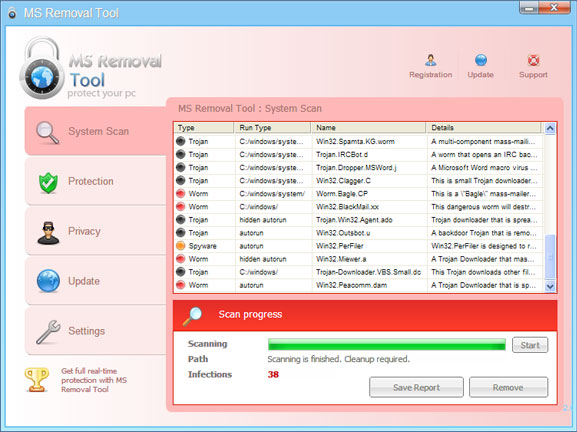 Fake
Microsoft Windows Malicious Software Removal Tool properties: Fake
Microsoft Windows Malicious Software Removal Tool properties:
• Changes browser settings
• Shows
commercial adverts
• Connects itself to the internet
• Stays resident in background
     
6:56 am edt
8/4/2011
MyPcSecure 04/08/11 - MyPcSecure is a rogue anti-spyware application that reports false threats and
displays fake security alerts to trick you into thinking
your computer is infected with malware.
This fake software is promoted and installed through the use of Trojans that
usually come from
bogus websites, such as fake online scanners or fake video web sites. Once installed,
MyPcSecure
will run a fake system scan and report false scan results. Then it
will ask you to
pay for a full version of the program in order to remove the infections. Of course, you shouldn't
buy it. The rogue program will also flood you computer with fake
security alerts stating that your
computer is under attack or seriously compromised. Just ignore those fake security
alerts and
false scan results. Please remove MyPcSecure from your computer.
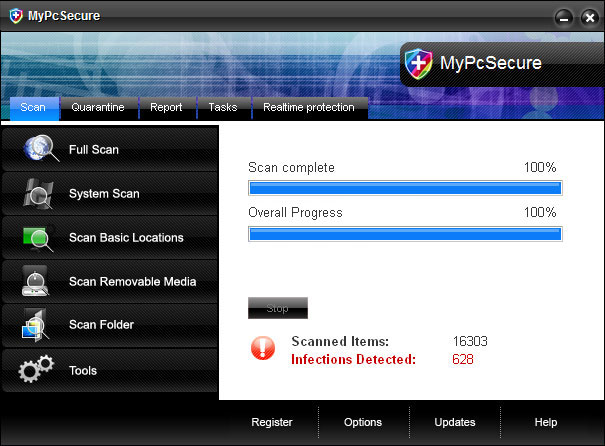 While running, MyPcSecure
will also impersonate Windows Security Center and display fake While running, MyPcSecure
will also impersonate Windows Security Center and display fake
notifications from Windows Task Bar. One of such fake notifications reads:
Security Center Alert!
Infiltration alert!
Your computer is being attacked
by an internet
virus. It could be a password-stealing attack,
a trojan-dropper or simular.
Do you want MyPcSecure
to block this attack?
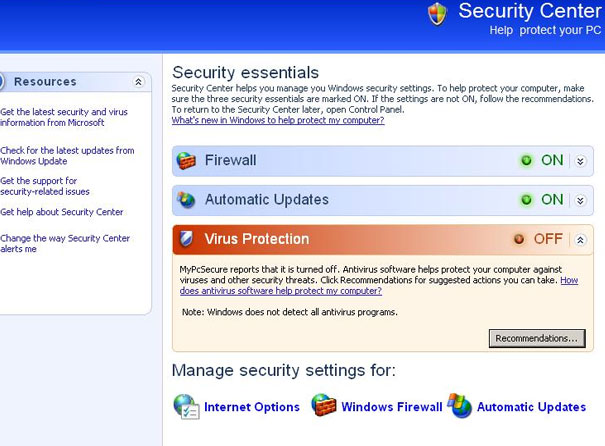 As for the fake Security
Center [Figure 2], it also states that your computer is not protected and As for the fake Security
Center [Figure 2], it also states that your computer is not protected and
that you should purchase the software in order
to protect yourself. What is more, MyPcSecure
will hijack Internet Explorer and redirect Google, Yahoo and other search results. However, the
most important thing is that this rogue program
comes bundled with rootkit infection. This is very
important because it's very hard to remove such infections manually.
That's why we strongly
recommend you to download an automatic removal tool (Listed below) and run a full system
scan with it.
MyPcSecure properties:
• Changes browser settings
• Shows commercial adverts
• Stays resident in background
     
10:11 pm edt
Malware Defender 2009 04/08/11 - Malware Defender 2009 is a rogue anti-spyware application. It is very similar to
System Guard
2009 and Spyware Guard 2009, so we can assume that these applications were
created by the same group of scammers. Malware
Defender 2009 is usually promoted along with
trojan viruses, such as Vundo or similar. These trojans display fake security
alerts and pop-up
windows about various security threats and advise you to download Malware Defender 2009 in
order to remove those infections or protect the system from further possible infections.
Once installed and
active, Malware Defender 2009 is configured to load automatically when user
starts his computer. The rogue performs fake
system scan and displays various malware
infections that can't be removed until user purchases the full version of Malware
Defender 2009.
However, all those infections are actually fake. They were made up in order to frighten the user,
hopeing
that he will buy the worthless spyware remover. Along with Malware Defender 2009
comes another infection called C:\Windows\System32\wcenter.exe.
This trojan may also display
a fake Windows Security Center window with various security problems. It is already obvious
that
Malware Defender 2009 should be removed as soon as possible after detection. Otherwise it can
cause more damage
and even decrease system performance.
 Use one of the automatic removal tools
listed below (Spyware Doctor) to remove this pest. Use one of the automatic removal tools
listed below (Spyware Doctor) to remove this pest.
     
4:12 am edt
8/3/2011
Windows Support System 03/08/11 - Windows Support System is a rogue anti-spyware program that displays fake security
alerts and non-existent infections. This rogue is typically
installed through the use of Trojans that
come from fake online scanners. The Windows Support System will pretend to
scan your
computer and detect malicious files but not allow them to be removed until the program is
purchased. The
rogue program wants to scare you into purchasing it. If you find that your
computer is infected then use our automated
tools below to remove Windows Support System
and related malware automatically using the removal tool given below.
While Windows Support System is running it will also display fake security warnings and alerts
on your computer.
These alerts will state that an active infection has been found and that you
should purchase the tool to remove all viruses
and to protect your computer against other
malware. Windows Support System will also block certain programs saying
that they are
infected. It may hijack your web browser as well. As you can see, this rogue was created to
trick
you into thinking that your computer has all sorts of malware so that you then purchase it.
The reality is that
Windows Support System is a scam. If you have already purchased the
program, then you should contact your credit
card company and dispute the charges. To
remove Windows Support System and the related Trojans, please use the removal
tools listed
below.
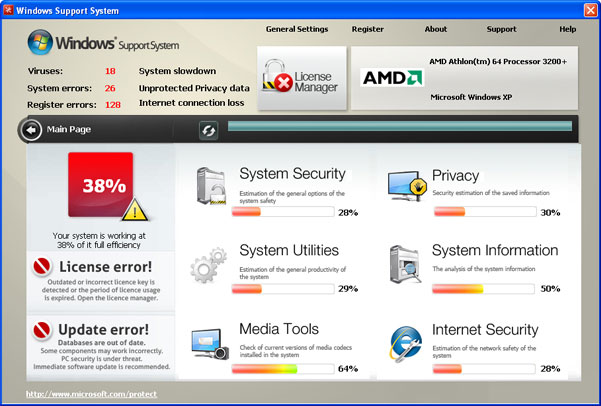 Windows Support
System properties: Windows Support
System properties:
• Changes browser settings
• Shows commercial adverts
• Connects
itself to the internet
• Stays resident in background
     
12:44 am edt
8/2/2011
Additional Guard 02/08/11 - Additional Guard is a misleading anti-spyware application, fake spyware removal tool.
Basically, it is just a rename of the rogue anti-spyware application called 'Windows Additional
Guard'. As its predecessor, Additional Guard uses false scan results and fake security
alerts/notifications to scare you into thinking that your computer
is infected and that you should
purchase the program to remove supposed infections/security threats. Obviously, this
is nothing
more than a scam. Do not buy this bogus software and uninstall Additional Guard from your
computer upon
detection.
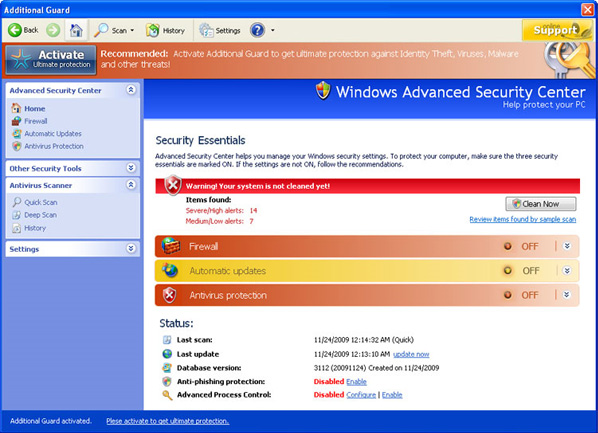 Additional Guard infection may cause
serious problems to the system. The rogue application is Additional Guard infection may cause
serious problems to the system. The rogue application is
promoted via fake online scanners and misleading websites. It enters a computer with the help of
Trojans that usually come from those
fake online scanners. Trojans then download and install
the rogue
application. Once installed, Additional Guard imitates several computer scans and
states that your computer is seriously
infected with spyware, adware, worms, Trojans and other
malware. This parasite then claims that you must purchase
Additional Guard in order to remove
those infections, but the problem is that those infections do not actually exist.
The real
infections come from Additional Guard itself.
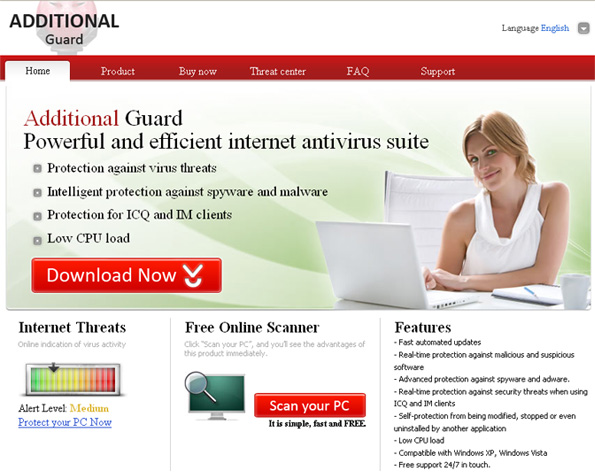 The home page of this malicious
software is additionalguard.net (they may use alternate URLs The home page of this malicious
software is additionalguard.net (they may use alternate URLs
also). The website is potentially harmful because there
are many false statements and fake
reviews as well as the pay page of this bogus application. Do not visit this website.
If you are
constantly redirected to this website, your computer is likely infected. As we have already said,
do
not purchase it! First of all, please scan your computer with
a legitimate anti-spyware
application to remove the remains or additionally downloaded malware.
 Additional
Guard properties: Additional
Guard properties:
• Changes browser settings
• Shows commercial adverts
• Stays resident
in background
     
3:48 am edt
8/1/2011
SecureVeteran 01/08/11 - SecureVeteran is classified as a misleading anti-virus application because it uses
false scan results and fake security alerts to
convince you that your computer is infected with
malware. Please
note that the only real infection is SecureVeteran itself. The rogue program is
installed through the use of Trojans,
fake online anti-spyware scanners and various misleading
websites that supposedly provide free online videos of well known TV shows. Most of the time,
the user is prompted to install
video codec to watch the requested video. Then an executable file
pop ups, for example vstream_udate.104.exe or
similar. Usually the file contains a Trojan virus
or it is a setup file for a particular rogue security program.
Once installed, SecureVeteran will be automatically configured to start each time you log into
Windows. It will imitate system scan and list a variety of infections that can't be removed
unless
you purchase the program. However, the scan results are false. The bogus program detects
harmless files that
were created during the installation process. You may safely ignore
all scan
results. Furthermore, SecureVeteran will impersonate Windows Security Center and display fake
notifications
about various system security threats and infections. It will also claim that your anti-
virus software is disabled and
that your PC is under attack by an Internet virus.
What
is more, Secure Veteran will block antivirus software and certain security related websites.
It will redirect you to
various misleading websites full of advertisements and fake software
reviews. As you can see, this program is a scam.
Do not purchase it! Please remove this
program as soon as possible.
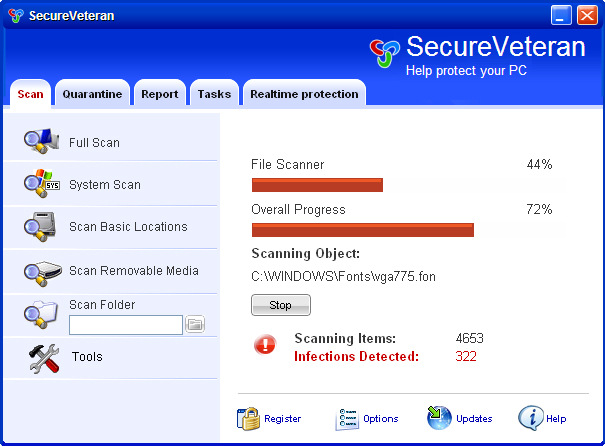 Secure Veteran properties: Secure Veteran properties:
• Changes browser settings
• Shows commercial adverts
• Stays resident in background
     
3:52 pm edt
XP Internet Security 2012
01/08/11 - XP Internet Security 2012 is a rogue security program that is promoted through the
use of Trojans. Once installed, trojans will impersonate an
Automatic Windows Updates window
and download the bogus program
onto your computer. When this fake program is running, it will
simulate a system scan and display a list of false system
security threats. Moreover, XP Internet
Security 2012 will flood your computer with fake security warnings and impersonate
Windows
Security Center to make this scam look more realistic. It will also hijack your web browser and
block antivirus
and anti-spyware programs. Finally the rogue program will ask you
to pay for a full
version of the program to remove the non-existing infections. Don't purchase it and remove XP
Internet
Security 2012 virus from your computer as soon as possible.
The bad news is that XP Internet Security 2012 (another
name of the virus) protects itself quite
effectively. It blocks legitimate security software and hijacks web browsers. In some cases it
blocks all programs, not only anti-virus or anti-spyware
software. What is more, it will detect
many well known and reputable websites as harmful and display fake security
alerts stating
that you may infect your PC if you open a particular website. And of course, it disables certain
Windows
functions such as Task Manager, Regedit and etc. It's possible to remove it manually,
but you have to re-enable those
Windows functions at first. You may also download an
automatic removal tool, but again have to you must fix some registry
entries and terminate the
main process of XP Internet Security 2012 which is AV.exe to be able to run the removal
tool.
Remove this parasite with Spyware Doctor or one of the automatic removal tools below as soon
as possible.
     
3:26 am edt
|
|
Q. How do I avoid rogue antispyware and antivirus software?
A. Make sure you 'Choose Industry Certified "Security Program"
Solutions'!
If your PC is connected to
the internet, uses e-mail, has software of an unknown
origin
installed and comes into contact with recordable media (jump drives, dvd's,
cd's, etc) Antispyware and Antivirus protection is a requirement. They help prevent
attacks through e-mail (and/or attachments sent with e-mail) and surfing the web.
They also help you eradicate infections which are the result
of security holes and
bugs in software. (The e-mail, web surfing
and software holes and bugs result in
the most serious internet
attacks).
One
way to know you're purchasing a trustworthy application is to confirm that
the program
you choose has earned certification from the leading labs.
Industry certification
from ICSA Labs, Virus Bulletin, West Coast Labs, the National
Association
of Specialist Computer Retailers, and others all require antispyware/
antivirus programs to meet stringent requirements to receive certification.
Smartphone and Tablet Tips to create a safe passcode.
Smartphones and tablets open the
door to your Work, friends, family, bank details, etc... No matter which device you use, follow these tips to keep your data secure.
1. Always use a passcode. If someone gets hold of your device, the person has immediate access to your apps and
data.
2. Make your passcode difficult to guess. Codes such as 1234 or 2580 can be cracked in seconds. Go for something that’s
unique but easy for you to remember.
3. Longer is stronger. The longer the passcode, the harder it is to crack. Make yours a minimum of six
digits.
4. Mix numbers and letters. If your device allows, use a passcode that combines numbers, letters and punctuation. Avoid dictionary words and
choose a memorable combination.
5. Make it unique. Don’t use the same passcode for anything else, including other devices,
bank cards or online accounts. That way, if one passcode gets hacked the rest stay secure.
6. Be discreet. Look around and make sure no one is watching you enter your passcode, just as
you would protect your PIN at the ATM machine.
Q. What steps need to be taken to secure
mobile devices (smartphones) for
personal/work phones and
tablets.
A. Follow these steps to secure your mobile
devices.
1. Secure your device
a.
Always lock it
b. Apply a complex passcode
c. Shield your passcode
d. Apply the latest patches
2.
Prevent Malware Infections
a.
Don't click on unsolicited links
b. Think before downloading apps
c. Don't "jailbreak" or "root" your mobile
3.
Be data aware
a.
Be careful what you share
b. Encrypt sensitive data
4. Stay compliant
a. Know and follow your organizations
security
policies
Q. Do you have an example of an Organizational 'Mobile Device Security Policy'
A. Here is EZMobilePC's policy.
1.
Introduction
Mobile devices, such as smartphones and tablet computers, are important tools for the
organization and their use
is supported to achieve business goals.
However, mobile devices
also represent a significant risk to information security and
data security as, if the
appropriate security applications and procedures are not applied,
they can be a conduit for
unauthorized access to the organization’s data and IT
infrastructure.
This can subsequently lead to data leakage and system infection.
EZMoblePC has a requirement to protect its information assets in order to safeguard
its customers, intellectual property and reputation. This document outlines a set of
practices and requirements for the safe use of mobile devices.
2.
Scope
1. All mobile devices, whether owned by EZMoblePC or owned by employees, that have
access to corporate networks, data and systems, not including corporate IT-managed
laptops. This includes smartphones and
tablet computers.
2. Exemptions: Where there is a business need to be exempted from this
policy
(too costly, too complex, adversely impacting other business requirements) a risk
assessment
must be conducted being authorized by security management.
3. Policy - Technical Requirements
1.
Devices must use the following Operating Systems: Android 2.2 or later,
iOS 4.x or later.
2. Devices must store all user-saved passwords in an encrypted password store.
3. Devices must be configured with a secure password that complies with EZMoblePC's
password policy. This password must not be the same as any other credentials used
within the organization.
4.
With the exception of those devices managed by IT, devices are not allowed to be
connected directly to the internal corporate network.
3.1 User Requirements
1.
Users must only load data essential to their role onto
their mobile device(s).
2.
Users must report all lost or stolen devices to EZMoblePC
IT immediately.
3.
If a user suspects that unauthorized access to company
data has taken place
via a mobile device, they must report the incident in alignment
with EZMoblePC’s
incident handling process.
4. Devices must not be “jailbroken”* or have any software/firmware installed
which
is designed to gain access to functionality not intended to be
exposed to the user.
5.
Users must not load pirated software or illegal content
onto their devices.
6.
Applications must only be installed from official platform-owner
approved sources.
Installation of code from un-trusted sources is forbidden.
If you are unsure if an
application is from an approved source contact EZMoblePC IT.
7. Devices must be kept up to date with manufacturer or network provided patches.
As a minimum patches should be checked for weekly
and applied at least once a month.
8.
Devices must not be connected to a PC which does not
have up to date and enabled
anti-malware protection and which does not comply with corporate
policy.
9.
Devices must be encrypted in line with EZMoblePC’s
compliance standards.
10.
Users may must be cautious about the merging of personal
and work email accounts on
their devices. They must take particular care
to ensure that company data is only sent
through the corporate email
system. If a user suspects that company data has been sent
from a personal email account, either in body text or as an attachment, they must notify
EZMoblePC IT immediately.
11.
(If applicable to your organization) Users must not
use corporate workstations to backup
or synchronize device content such as media files, unless such content is required
for
legitimate business purposes.
*To jailbreak a mobile device is to remove the limitations imposed by the manufacturer.
This gives access to the operating system, thereby unlocking all its features and enabling
the installation of unauthorized software.
Q. What is the first thing I should
do when I turn on my computer.
A. Back up important files
If you follow these tips, you're more likely to be free of interference from
hackers,
viruses,
and spammers. But no system is completely secure. If you have important
files stored on your computer, copy them onto a removable disc or
an external
hard
drive, and store it in a safe place.

Q. How do I protect my password?
A. Protect your passwords
Keep your passwords in a secure place, and out of plain sight. Don't share them
on the Internet, over email, or on the phone. Your Internet Service Provider (ISP)
should never ask for your password. In addition, hackers
may try to figure out your
passwords to gain access to your computer. To make it tougher for
them:
Use passwords that have at least eight characters and include numbers or symbols.
The longer the password,
the tougher it is to crack. A 12-character password is
stronger than one with eight characters.
Avoid common word: some hackers
use programs that can try every word in the
dictionary.
Don't use your personal information, your login name, or adjacent keys on the
keyboard as passwords.
Change your passwords regularly (at a minimum, every 90 days).
Don't use the same password for each online account you access.
Q. What steps need to be taken when
setting up Wireless Home Network Security.
1) Change Default Administrator Passwords (and Usernames)
Changing the default password is important because everyone
that purchases the same
Wireless access device, knows your password.
2) Turn on (Compatible) WPA / WEP Encryption
By default, your Wireless device comes
without the encryption enables. WPA / WEP are
security programs that forced your computer to provide
an encrypted password before
you are allowed access
to the wireless access point.
3) Change the Default SSID
SSID is the network name of your wireless network;
most people leave the default name,
such as, Linksys or NetGear. By changing the name, intruders have a more difficult time
identifying your system and use known vulnerabilities. (And
of course, use the unchanged
default password.) One
mistake people make is naming their home network their family
name and or address. When cruising a neighborhood of wireless devices, its always
scary to see Bobsnet444.
4) Disable SSID Broadcast
In Wi-Fi networking, the access point or router typically broadcasts
the network name
(SSID) over the air at
regular intervals. This feature was designed for businesses and
mobile hotspots where Wi-Fi clients may come and go. In the home, this feature is
unnecessary, and
it increases the likelihood an unwelcome neighbor or hacker will try
to
log in to your home network.
5) Assign Static IP Addresses to Devices
Most home networkers gravitate toward using dynamic IP addresses.
This means that
the IP Address, (the IP
Address is needed to participate on a network.) is typically
assigned automatically. A dynamic IP address on an unsecure system can also supply
a hacker with a IP Address.
6) Enable MAC Address Filtering
Each piece of Wi-Fi gear possesses a unique identifier called the "physical address"
or "MAC address." Access points and routers keep
track of the MAC addresses of all
devices that connect to them. Many such products offer the owner an option to key in the
MAC addresses of
their home equipment that restricts the network to only allow
connections from those devices. Do this, but also know that the feature is not so powerful
as it may seem. Hacker software programs
can fake MAC addresses easily.
7) Turn Off the Network During Extended Periods of Non-Use
The ultimate in security measures for any wireless network
is to shut down, or turn office
your wireless access point
when you are not using. You are the most vulnerable at work
or asleep, and mischief minded people know it.
8) Position the Router or Access Point Safely
Wi-Fi signals normally reach to the exterior of a home. A small amount
of "leakage"
outdoors is not a problem,
but the further this signal reaches, the easier it is for others
to detect and exploit. Wi-Fi signals often reach across streets and through neighboring
homes. When installing a wireless home network, the position
of the access point or
router determines it's reach. Try to position these devices near the center of the home
rather than near windows to minimize
this leakage.
Q: What are the first security steps I should take before I connect my computer to the internet?
A: Practices Before You Connect a New Computer to the Internet
We advise home users to download and install software patches
as soon as possible after connecting a
new computer to the
Internet. However, since the background intruder scanning activity
is constant, it may not be possible for the user to complete the
download and installation of software
patches before the vulner-
abilities they are trying to fix are exploited. We recommend the
following actions 'before' connecting computers to the Internet
so
that
users can complete the patching process without incident.
Q. Where do I report
Hacking or Malware activity?
A. Here is where to report:
Hacking or a Computer Virus
Alert the appropriate authorities by contacting: Your ISP and the hacker's ISP (if you can tell what it is). You can
usually find an ISP's email
address on its website. Include information on the
incident from your firewall's log file. By alerting the ISP to the
problem on its system,
you can help it prevent similar problems in the future. The FBI at www.ic3.gov. To
fight computer criminals, they need to hear from you.
Internet
Fraud If a scammer takes advantage of you through an
Internet auction,
when you're shopping
online, or in any other way, report it to the Federal Trade
Commission, at ftc.gov. The FTC enters Internet, identity theft, and other fraud-related complaints into Consumer Sentinel, a secure, online database available to hundreds
of civil and criminal law enforcement agencies in the U.S. and abroad.
Deceptive
Spam If you get deceptive spam, including email phishing
for your
information, forward it
to spam@uce.gov. Be sure to include the full header of the email, including all routing information. You also may report phishing email to
of ISPs, security vendors, financial institutions and law enforcement agencies,
uses these reports to fight phishing.
Divulged
Personal Information If you believe you have mistakenly
given your
personal information to
a fraudster, file a complaint at ftc.gov, and then visit the Federal Trade
Commission's Identity Theft website at ftc.gov/idtheft to learn how to minimize your risk
of damage from a potential theft of your identity.
Parents Parents sometimes can feel outpaced by their technologically savvy
kids. Technology aside, there are lessons that parents can teach to help kids
stay safer as they socialize online. Most ISPs provide parental
controls, or you
can buy separate
software. But no software can substitute for parental supervision.
Talk to your kids about safe computing practices, as well as the things they're
seeing and doing online.
Social Networking
Sites Many adults, teens, and tweens use social networking
sites to exchange information about themselves, share pictures and
videos, and
use blogs and private
messaging to communicate with friends, others who share
interests, and sometimes even the world-at-large. Here are some tips for parents
who want their kids to use these sites safely:
Use privacy settings to restrict who can access and post on your
child's website. Some social networking sites have strong privacy
settings. Show
your child how to
use these settings to limit who can view their online profile, and
explain to them why this is important.
Encourage your child to think about the language used in a blog,
and to think before posting pictures and videos. Employers, college
admissions
officers, team coaches,
and teachers may view your child's postings. Even a kid's
screen name could make a difference. Encourage teens to think about the
impression that screen names could make.
Remind your kids that once they post information online, they can't
take it back. Even if they delete the information from a site, older
versions may
exist on other people's
computers and be circulated online.
Talk to your kids about bullying. Online bullying can take many forms,
from spreading rumors online and posting or forwarding private messages
without
the sender's OK, to sending
threatening messages. Tell your kids that the words
they type and the images they post can have real-world consequences. They can
make the target of the bullying feel bad, make the sender look bad
— and, some-
times, can bring
on punishment from the authorities. Encourage your kids to talk to
you if they feel targeted by a bully.
Talk to your kids about avoiding sex talk online. Recent research
shows that teens who don't talk about sex with strangers online
are less likely to
come in contact
with a predator.
Tell your kids to trust their instincts if they have suspicions. If they feel threatened by
someone or uncomfortable because of something online, encourage
them to tell you.
You can then help
them report concerns to the police and to the social networking
site. Most sites have links where users can immediately report abusive, suspicious,
or inappropriate activity.

Q. What is the best way to keep malware
out.
A.
Try to minimize the threat.
Minimizing
the Effects of Malware on Your Computer
Malware is short for “malicious software;” it includes viruses —
programs that copy
themselves without your permission — and spyware, programs installed without
your consent to monitor or control your
computer activity. Criminals are hard at work
thinking up creative ways to get malware on your computer. They create appealing
web sites, desirable downloads, and compelling
stories to lure you to links that will
download malware, especially on computers that don’t use adequate security
software. Then, they use the malware to
steal personal information, send spam,
and commit fraud.It doesn’t have to be that way.
So says a website with tips from
the federal government and the technology industry that is helping consumers be on
guard against Internet fraud, secure their
computers, and protect their personal
malware can wreak, and reclaim their computers and their electronic information.
Computers may be infected with malware if they:
-
slow down, malfunction, or display repeated error messages;
- wont shut down or restart;
-
serve up a lot of pop-up ads, or display them when youre not surfing
the web;
or
-
display web pages or programs you didnt intend to use, or send emails
you
didnt write.
If you suspect malware
is on your computer
If you suspect malware is lurking on your computer, stop shopping, banking, and
other online activities that involve user names, passwords, or other
sensitive inform-
ation.
Malware on your computer could be sending your personal information to
identity thieves.
Then, confirm that your security software is active and current:
at a minimum, your
computer
should have anti-virus and anti-spyware software, and a firewall. You can
buy stand-alone programs for each element or a security suite that
includes these
programs
from a variety of sources, including commercial vendors or from your
Internet Service Provider. Security software that comes pre-installed on a computer
generally works
for a short time unless you pay a subscription fee to keep it in effect.
In any case, security software protects against the newest threats
only if it is up-to-
date.
Thats why it is critical to set your security software and operating system (like
Windows or Apples OS) to update automatically.
Some scam artists distribute malware disguised as anti-spyware software. Resist
buying software in response to unexpected pop-up messages or emails,
especially
ads
that claim to have scanned your computer and detected malware. Thats a tactic
scammers have used to spread malware, and that has attracted the attention
of the
Federal
Trade Commission, the nations consumer protection agency, as well as a
security tools from legitimate security vendors selected by GetNetWise, a project
of
the Internet
Education Foundation.
Once you confirm that
your security software is up-to-date, run it to scan your compu-
ter for viruses and spyware. Delete everything the program identifies as a problem.
You
may have to restart your computer for the changes to take effect.If you suspect
that your computer still is infected, you may want to run a second anti-spyware
or
anti-virus
program. Some computer security experts recommend installing one
program for real-time protection, and another for periodic scans of your machine
as
a
way to stop malware that might have slipped past the first program.
Finally, if the problem persists after you exhaust your own ability to diagnose and
treat it, you might want to call for professional
help. If your computer is covered by a
warranty that offers free tech support, contact the manufacturer. Before you call,
write down the model and serial number of
your computer, the name of any software
you’ve installed, and a short description of the problem. Your notes will help you give
an accurate description to the technician.If you need professional help, if your
machine isn’t covered by a warranty, or if your security software isn’t
doing the job
properly, you may need to pay for technical support. Many companies — including
some affiliated with retail stores —
offer tech support via the phone, online, at their
store, or in your home. Telephone or online help generally are the least expensive
ways
to access support services — especially if there’s a toll-free helpline — but you
may have to do some of the work yourself.
Taking your computer to a store usually is
less expensive than hiring a technician or repair person to come into your home.
Once your computer is back
up and running, think about how malware could have
been downloaded to your machine, and what you could do to avoid it in the future. If
your security software or operating system was
out-of-date, download the newest
version and set it to update automatically. Use the opportunity to back up important
files by copying them onto a removable disc. Other
ways to minimize the chances
of a malware download in the future:
-
Don’t click on a link in an email or open an attachment unless you
know who sent it and what it is. Links in email can send you to sites
that automatically download malware to your machine. Opening
attachments — even those that appear to come from a friend or
co-worker — also can install malware on your computer.
-
Download and install software only from websites you know and trust.
Downloading free games, file-sharing programs, and customized
toolbars may sound appealing, but free software can come with
malware.
-
Talk about safe computing. Tell your kids that some online activity
can
put a computer at risk: clicking on pop-ups, downloading free games or
programs, or posting personal information.
Finally, monitor your computer
for unusual behavior. If you suspect your machine
has been exposed to malware, take action immediately. Report problems with
malware to your ISP so it can try to prevent similar problems and
alert other

Q. What Should Parents know about Social
Networking Sites?
A. Social Networking
Sites
"It's 10 p.m. Do you know where your
children are?
"Remember that phrase from your own childhood? It's still a valid question, but now, it comes with a twist:
"Do you know where your kids are — and who they're chatting with online?
"Social networking sites have morphed into
a mainstream medium for teens and adults. These sites
encourage and enable people to exchange information
about themselves, share pictures and videos,
and
use blogs and private messaging to communicate with friends,
others who share interests, and
sometimes
even the world-at-large. And that's why it's important
to be aware of the possible pitfalls that
come
with networking online.
Some social networking
sites attract pre-teens – even kids as young as 5 or 6. These younger-focused
sites don't allow the same kinds of communication
that teens and adults have, but there are still things
that parents can do to help young kids socialize
safely online. In fact, when it comes to young kids, the
law provides some protections – and gives parents some control over the type of information that
children can disclose online. For sites directed to children under age 13, and for general audience sites
that know
they're dealing with kids younger than 13, there's the Children's Online Privacy Protection Act
(COPPA). It requires
these sites to get parental consent before they collect, maintain, or use kids'
Information. COPPA also allows parents to review their child's online profiles and blog pages.
Parents sometimes can feel outpaced by their technologically savvy kids.
Technology aside, there are
lessons that parents
can teach to help kids stay safer as they socialize online.
Help Kids Socialize Safely OnlineOnGuard Online shares these tips for safe social networking:
Help
your kids understand what information should be private. Tell them why it's important to
keep some things – about themselves, family members and friends
– to themselves.
Information like their full name, Social Security number, street address, phone number,
and
family financial information — like bank or credit card Account numbers
— is private and
should stay that way. Tell them not to choose a screen name that gives away too
much
personal information.
Use privacy settings to restrict who can access and post on your child's website. Some
social networking sites have strong privacy settings.
Show your child how to use these settings to limit who can view their online profile,
and
explain to them why this is important.
Explain that kids should post only information that you — and they — are comfortable
with others seeing. Even If privacy settings are turned on, some — or even all
— of your
child's profile may be seen by a broader audience Than you're comfortable with.
Encourage your child to think about the language used in a blog, and to think before
Posting pictures and videos. Employers, college admissions officers, team coaches,
and teachers may view your child's postings.
Even a kid's screen name could make a difference. Encourage teens to think about the
impression that screen names could make.
Remind your kids that once they post information online, they can't take it back.
Even if they delete the Information from a site, older versions may exist on other
people's computers and be circulated online.
Know how your kids are getting online. More and more, kids are accessing the Internet
through their cell phones.
Find out about what limits you can place on your child's cell phone. Some cellular
companies have plans that limit downloads, Internet access, and texting; other plans
allow kids to use those features only at certain times of day.
Talk to your kids about bullying. Online bullying can take many forms, from spreading
rumors online and posting or forwarding private messages without the sender's
OK, to
sending threatening messages. Tell your kids that the words they type and the
images
they post can have real-world consequences. They can make the target of the
bullying feel bad, make the sender look bad – and, sometimes, can bring on
punishment from the authorities.
Encourage your kids to talk to you if they feel targeted by a bully.
Talk to your kids about avoiding sex talk online. Recent research shows that teens who
don't talk about sex with strangers online are less likely to come in contact with
a
predator.If you're concerned that your child is engaging in risky online behavior,
you can
search the blog sites they visit to see whatinformation they're posting. Try searching
by their name, nickname, school, hobbies, grade, or area where you live.
Tell your kids to trust their gut if they have suspicions. If they feel threatened by someone
or uncomfortable because of something online, encourage them to tell you. You
can then
help them report concerns to the police and to the social networking site. Most
sites have
links where users can immediately report abusive, suspicious, or inappropriate
online
behavior.
Read sites'
privacy policies. Spend some time with a site's privacy policy, FAQs, and
parent sections to Understand its features and privacy controls. The site should
spell out
your rights as a parent to review and delete your child's profile if your child
is younger
than 13.
A Few More Tips to Protect Pre-TeensMany of the tips above apply for pre-teens, but
parents of younger children also can:
Take
extra steps to protect younger kids. Keep the computer in an open area like the
kitchen or family room, so you can keep an eye on what your kids are doing online.
Use the Internet with them to help develop safe surfing habits.
Consider taking advantage of parental control features on some operating systems
that let you manage your kids' computer use, including what sites they can visit,
whether they can download items, or what time of day they can be online.
Go where your kids go online. Sign up for – and use – the social networking spaces
that your kids visit. Let them know that you're there, and help teach them how to act
as they socialize online.
Review your child's friends list. You may want to limit your child's online “friends” to
people your child actually knows and is friendly with in real life.
Understand sites' privacy policies. Sites should spell out your rights as a parent to
review and delete your child's profile if your child is younger than 13.
For More InformationTo learn more about staying safe online, visit the websites of the following organizations:
Federal Trade Commission — www.OnGuardOnline.gov The FTC works for the consumer to prevent fraudulent, deceptive, and unfair business
practices in the marketplace and toprovide information to help consumers spot, stop, and avoid them.
To file a complaint or to get free information onconsumer issues, visit ftc.gov or call toll-free, 1-877-FTC-HELP
(1-877-382-4357); TTY: 1-866-653-4261.The FTC manages OnGuardOnline.gov, which provides practical tips
from the federal government and the technologyindustry to help you be on guard against Internet fraud,
secure your computer, and protect your personal information. ConnectSafely — www.connectsafely.org ConnectSafely is a forum for parents, teens, educators, and advocates designed
to give teens and parents a voice in thepublic discussion about youth online safety, and has tips, as
well as other resources, for safe blogging and socialnetworking. Along with NetFamilyNews.org, it is
a project of the non- profit Tech Parenting Group. Cyberbully411 — www.cyberbully411.org Cyberbully411 provides resources and opportunities for discussion and sharing
for youth - and their parents - who havequestions about or may have been targeted by online harassment.
The website was created by the non-profit Internet Solutions for Kids, Inc., with funding from the Community
Technology Foundation of California. GetNetWise — www.getnetwise.org GetNetWise is a public service sponsored by Internet industry corporations and
public interest organizations to helpensure that Internet users have safe, constructive, and educational
or entertaining online experiences. The GetNetWise coalition works to provide Internet users with the
resources they need to make informed decisions about their and theirfamily's use of the Internet.
iKeepSafe.org is a coalition of 49 governors/first spouses, law enforcement,
the American Medical Association, the American Academy of Pediatrics, and other associations dedicated
to helping parents, educators, and caregivers byproviding tools and guidelines to promote safe Internet
and technology use among children.
NCMEC is a private, non-profit organization that helps prevent child abduction
and sexual exploitation; helps find missingchildren; and assists victims of child abduction and sexual
exploitation, their families, and the professionals who serve them. staysafe —
www.staysafe.org staysafe.org is an educational site intended to help
consumers understand both the positive aspects of the Internet aswell as how to manage a variety of
safety and security issues that exist online.
WiredSafety.org is an Internet safety and help group. WiredSafety.org provides
education, assistance, and awareness on cybercrime and abuse, privacy, security, and responsible technology
use. It is also the parent group of Teenangels.org, FBI-trained teens and preteens who promote Internet
safety. See also: Social Networking Sites: Safety Tips for Tweens and Teens What to Do if There's a ProblemTrust your gut if you have
suspicions. If you feel threatened by someone or uncomfortable because of something online,Tell an adult
you trust, and report it to the police and the social networking site.The Children's Online Privacy
Protection Act (COPPA) requires websites to obtain parental consent before collecting, using,or disclosing
personal information from children under age 13.
Q. What are
Nigerian con-men or internet scams?
A.
Phony Lotteries, Nigerian 419s, Advanced Fee Fraud, and Scams
While you're online:
Know who you're
dealing with.
In any electronic transaction, independently confirm the other party's name, street
address, and telephone number.
Resist the urge to enter foreign lotteries. These solicitations are phony
and illegal.
Delete requests that claim to be from foreign nationals
asking you to help transfer their money through your bank account. They're fraudulent.
Ignore unsolicited
emails that request your money, credit card or account numbers, or other personal information.
If you are selling something over the Internet, don't accept a potential buyer's offer to send you a check
for more than the purchase price, no matter how tempting the plea or convincing the story. End the transaction immediately
if someone insists that you wire back funds.The Internet gives buyers access to a world of goods and services, and gives sellers access to a world of customers.
Unfortunately, the Internet also gives con artists the very same access. But being on guard online can help you maximize the
global benefits of electronic commerce and minimize your chance of being defrauded. OnGuard Online wants you to know how to
spot some cross-border scams — including foreign lotteries, money offers, and check overpayment schemes — and
report them to the appropriate authorities.
Foreign Lotteries
For years, scam operators have used the telephone and direct mail to entice U.S. consumers into buying chances in supposedly
high-stakes foreign lotteries. Now they're using email, too — either to sell tickets or suggest that a large cash prize
has your name on it. No matter what country's name is used to promote a lottery, the pitch follows a pattern: you should send
money to pay for taxes, insurance, or processing or customs fees. The amount may seem small at first, but as long as you keep
paying, the requests for funds will keep coming — for higher and higher amounts. Some victims have lost thousands of
dollars.Most scam operators never buy the lottery tickets on your behalf. Others buy some tickets, but keep the "winnings"
for themselves. In any case, lottery hustlers generally try to get you to share your bank account or credit card numbers,
so they can make unauthorized withdrawals.If you're thinking about responding to a foreign lottery, OnGuard Online wants you to remember:
Playing
a foreign lottery is against the law.
There are no secret systems for winning foreign lotteries. Your chances of getting any money back are
slim to none.
If you buy even one foreign lottery ticket, you can expect many more bogus offers
for lottery or investment "opportunities." Your name will be placed on "sucker lists" that fraudsters
buy and sell.
Keep your
credit card and bank account numbers to yourself. Scam artists often ask for them during an unsolicited sales pitch. Once
they get your account numbers, they may use them to commit identity theft.Resist solicitations for foreign lottery promotions. Report them to the appropriate government officials, then hit delete.View a sample fraudulent foreign lottery solicitation.
"Nigerian" Foreign Money Offers
The "Nigerian" scam got its name from emails that supposedly came
from Nigerian "officials" who needed your help getting at their money — which was tied up due to strife in
their country. Today, people claiming to be officials, businesspeople, or the surviving relatives of former government honchos
in countries around the world send countless offers via email to transfer thousands of dollars into your bank account if you
will just pay a fee or "taxes" to help them access their money. If you respond to the initial offer, you may receive
documents that look "official." But then, you will get more email asking you to send more money to cover transaction
and transfer costs, attorney's fees, blank letterhead, and your bank account numbers, among other information. Subsequent
emails will encourage you to travel to another country to complete the transaction. Some fraudsters have even produced trunks
of dyed or stamped money to verify their claims.The emails are from crooks trying to steal your money or commit identity
theft. Victims of this scam report that emergencies arise that require more money and delay the "transfer" of funds;
in the end, you lose your money, and the scam artist vanishes. According to the U.S. State Department, people who have responded
to these solicitations have been beaten, subjected to threats and extortion, and in some cases, murdered.If you receive an
email from someone claiming to need your help getting money out of another country, don't respond. After all, why would a stranger from another country pick you out at random to share thousands of
dollars? Report the solicitation to the appropriate government officials, and then hit delete.View a sample fraudulent foreign money offer.
Check Overpayment Schemes
Say
no to a check for more than your selling price, no matter how tempting the plea or convincing the story. Check overpayment
schemes generally target people who have posted an item for sale online. The con artist, posing as a potential buyer from
a foreign country (or a distant part of the U.S.), emails the seller and offers to buy the item with a cashier's check, money
order, personal check, or corporate check. Or the scammer may pretend to be a business owner from a foreign country, needing
"financial agents" to process payments for their U.S. orders; in exchange, they promise a commission.Regardless of the cover, here's what happens:
The scammer sends you a check that looks authentic — complete with watermarks — made payable for more money than
you expected. They ask you to deposit it in your bank account, and then wire-transfer some portion of the funds to a foreign
account. They provide convincing reasons why the check is for more than the necessary amount, and why the funds must be transferred
quickly. Sometimes, the counterfeit checks fool a bank teller, but be aware that the check still can bounce. The scammer vanishes
with the money you wired from your own account and you are on the hook for the entire amount of the worthless check. In addition,
a scammer who has your bank account number is likely to use it to withdraw more money from your account.
Reporting a Cross-Border Scam
If you think you may have responded to a cross-border scam, file a complaint at www.econsumer.gov, a project of 20 countries of the International Consumer Protection and Enforcement
Network. Then visit the FTC's identity theft website at www.ftc.gov/idtheft. While you can't completely control whether you will become a victim
of identity theft, you can take some steps to minimize your risk.If you've responded to a "Nigerian" scheme, contact your
local Secret Service field office using contact information from the Blue Pages of your telephone directory, or from www.secretservice.gov/field_offices.shtml.In addition, report telemarketing fraud and check overpayment scams to your state
Attorney General, using contact information at www.naag.org.Report unsolicited email offers to spam@uce.gov — including offers inviting you to participate in a foreign
lottery, looking for help getting money out of a foreign country, or asking you to wire back extra funds from a check you
received.If you receive what looks like lottery material from a foreign country through the postal mail, give it to your local
postmaster.
For More InformationForeign Lottery Scams
U.S. Federal Trade Commission — The FTC works for the consumer to prevent fraudulent, deceptive,
and unfair business practices in the marketplace and to provide information to help consumers spot, stop, and avoid them.
To file a complaint or to get free information on consumer issues, visit www.ftc.gov or call toll-free, 1-877-FTC-HELP (1-877-382-4357); TTY: 1-866-653-4261.
The FTC enters Internet, telemarketing, identity theft, and other fraud-related complaints into Consumer Sentinel, a secure,
online database available to hundreds of civil and criminal law enforcement agencies in the U.S. and abroad.Competition Bureau in Canada — The Competition Bureau is an independent law enforcement agency
in Canada that investigates anti-competitive practices and promotes compliance with the
laws under its jurisdiction. To file a complaint or to get free information, visit www.competitionbureau.gc.ca or call toll-free, 1-800-348-5358. The Bureau has the ability to refer criminal matters to the Attorney General of Canada,
who then decides whether to prosecute before the courts.United Kingdom's Office of Fair Trading — The United Kingdom's
Office of Fair Trading is responsible for making markets work well for consumers. They protect and promote consumer interests
throughout the United Kingdom, while ensuring that businesses are fair and competitive. To file a complaint or to get free information,
visit www.oft.gov.uk or send an email to enquiries@oft.gsi.gov.uk.Australian Competition and Consumer Commission — The Australian Competition and Consumer Commission encourages vigorous
competition in the marketplace and enforces consumer protection and fair trading laws. To file a complaint or to get more
information, visit www.accc.gov.au. The ACCC advocates consultation and negotiation as the first and
best option to settle disputes, but once the ACCC pursues legal action any sort of mediation becomes less likely.
"Nigerian" Advance-Fee Scams
U.S. Secret Service — The Secret Service investigates violations of laws relating to financial
crimes, including access device fraud, financial institution fraud, identity theft, and computer fraud. To file a complaint
or to get free information, visit www.secretservice.gov or call 202-406-5708.U.S. Department of State — The Department of State's mission is to create a more secure, democratic,
and prosperous world for the benefit of the American people and the international community. As part of that mission, the
Department of State seeks to minimize the impact of international crime, including cross-border internet scams, on the United States and its citizens. To get free information, visit www.state.gov.
Q. What should I do prior to disposing of an old computer?
A. Computer Disposal
Once you have a “clean” computer,
consider recycling, donating, or reselling it – and keep the environment in mind when
disposing of your computer.If you want to get rid of your old computer, options include recycling,
reselling, and donating.
But before
you log off for thelast time, there are important
things to do to prepare it for disposal. Computers
often hold
personal and financial
information, including passwords, account numbers, license keys or registration numbers for software
programs, addresses and phone numbers, medical and prescription information, tax returns, and other personal documents.
Before getting rid of your old computer, it’s a good idea to use software to “wipe”the hard drive clean. If you don’t, consider
your old hard drive a 21st century treasure chest for identity thieves
and information pirates. The Federal Trade Commission
(FTC), the nation’s consumer
protection agency, says you can deter identity theft and information piracy by taking a few
preventive steps.
Understanding Hard Drives
A computer’s hard
drive stores data, and maintains an index of files. When you save a file, especially a large one, it is
scattered around the hard drive in bits and
pieces. Files also are automatically created by browsers
and operating
systems. When you open a file, the hard drive checks the index, then gathers
the bits and pieces and reconstructs them.
When you
delete a file, the links between the index and the file disappear, signaling to your system that the file isn’t needed
any longer and that hard drive space
can be overwritten. But the bits and pieces of the deleted file stay on your computer
until they’re overwritten, and they can be retrieved with a data recovery program.
To remove data from your hard drive
permanently,
it needs to be wiped clean.
Cleaning Hard Dives
Before you clean your hard
drive, save the files that are important to you on an external storage device – for example,
a USB drive, a CDRom, or an external
hard drive – or transfer them to a new computer. Check your owner’s manual, the
manufacturer’s website, or its customer support line for information on how to
save data and transfer it to a new
computer. Utility programs to wipe your hard drive are available both online and in stores where computers are
sold.
They’re generally inexpensive; some are available on the Internet for free. Wipe utility
programs vary in their capabilities:
some
erase the entire disk, while others allow you
to select files or folders to erase. They also vary in their effectiveness:
programs that overwrite
or wipe the hard drive many times are very effective; those that overwrite or wipe the drive only once
may not prevent information being wiped from being recovered later.
If your old computer contains sensitive information
that would be valuable to an identity
thief, consider using a program that overwrites or wipes the hard drive many times. Or,
remove the hard
drive, and physically destroy it. One more thing to keep in mind: If you use your home or personal
computer
for business purposes, check with your employer about how to manage information on your computer that’s business-related.
The law requires businesses to follow
data security and disposal requirements for certain information that’s related to
customers.
Disposal
Options
Once you have a “clean”
computer, here’s how to dispose of it:
Recycle it. Many computer manufacturers have programs to recycle computers
and components. Check their
websites or call their toll-free numbers
for more information. The Environmental Protection Agency (EPA) has
information on electronic product recycling
programs at
program. Check with your county or local government,
including the local landfill office for regulations.
Donate it. Many organizations collect old computers and donate them to charities.
Resell it. Some people and organizations buy old computers.
Check online. Keep
the environment in mind when disposing of your computer.
Most computer equipment contains hazardous materialsthat don’t belong in a landfill.
For example, many computers have heavy metals that can contaminate the earth.
The EPA recommends that you check with your local health and sanitation agencies for ways to dispose
of electronics safely.
www.hypersmash.com
hostgator promo
